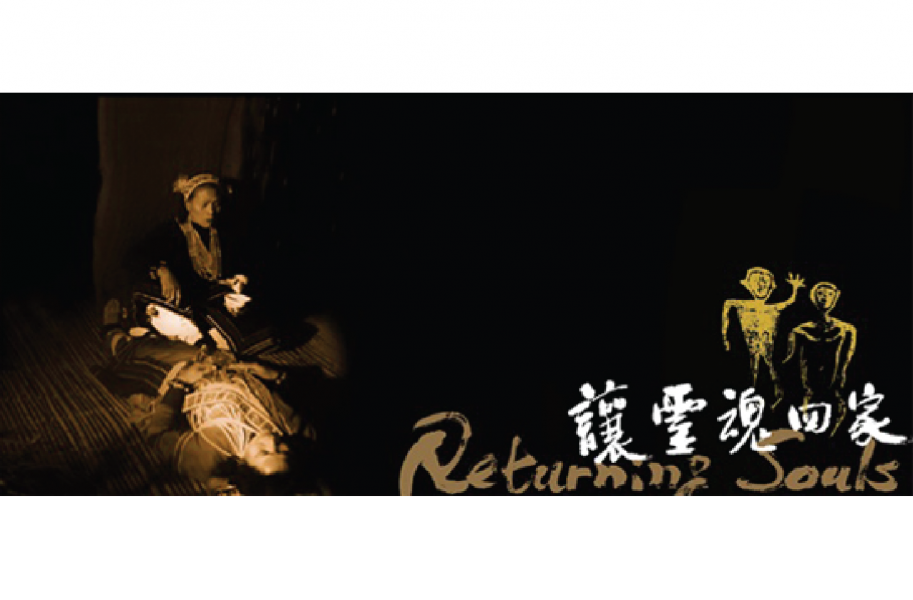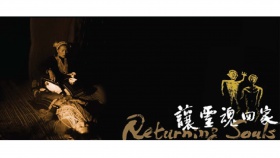Returning Souls
Country:
- Taiwan
Language:
- Mandarin
- Amis
- Gender
- Ethnology
- Folk
- Religion


Synopsis
In the historically most famous ancestral house of the matrilineal Amis tribe in Taiwan, the carved pillars tell legends, such as the great flood, the glowing girl, the descending shaman sent by the Mother Sun, and the father-killing headhunting event. After a strong typhoon toppled the house 40 years ago, the pillars were moved to the Institute of Ethnology Museum. Recently young villagers, with assistance from female shamans, pushed the descendants and village representatives to communicate with ancestors in the pillars. They eventually brought the ancestral souls(rather than the pillars)back and began reconstructing the house. In an environment highly influenced by western religions, national land policy, and local politics, the dream of the young people for cultural revitalization and to bring back not only the ancestral souls but also the soul of the village encountered many frustrations. This documentary interweaves reality and legends as well as the seen and the unseen as it records this unique case of repatriation.
Copyright © HU Tai-li. All Rights Reserved.
Director Statement
Why I was inspired to film Returning Souls
Filming a documentary does not serve to simply document facts. By sharing what I have recorded, I hope to stimulate reflection in my audience on a variety of cultural issues. In all my experience performing anthropological research and filming ethnographic documentaries, “Returning Souls” has the closest links to my workplace, Academia Sinica’s Institute of Ethnology. In August 2003, when young members of the Amis tribe from Tafalong visited the Museum of Institute of Ethnology, I was Convener of the Institute’s Museum Committee. I could feel that something special had been put into motion. This story literally appeared on my doorstep and there was no way I could ignore it. Picking up a video camera is my natural reflex, but it is also an ideal tool for organizing thoughts, observing changes, recording communication, and introspection.
I was truly moved by the group of young Amis from Tafalong, led by Fuday. They came to request the return of wooden pillars from the Kakita’an family ancestral house that are preserved in the Institute’s museum. By bringing the pillars home, they hoped to restore the soul of their village that had been eaten away by the destruction of the Kakita’an ancestral house, the displacement of their ancestors’ souls, and the impact of outside culture on their way of life. If we can just bring back the pillars and rebuild the Kakita’an ancestral house, they thought, we can recapture our culture and rituals and revitalize the spirit of Tafalong.
Before Taiwan was settled by large numbers of ethnic Han Chinese, it was inhabited by Austronesian-speaking peoples. Today, the Taiwanese government recognizes 14 indigenous tribes with a combined 520,000 members who make up 2.25% of Taiwan’s population. The largest of Taiwan’s tribes, the Amis, has nearly 200,000 members who primarily reside along the island’s eastern coast. With years of experience researching Taiwan’s Paiwan tribe, I am not unfamiliar with carved columns in the houses of Paiwan nobility. However, in the accumulated literature on the matrilineal Amis, the Kakita’an ancestral house in Tafalong is the only recorded structure with carved pillars. With carvings depicting dramatic tales of a big flood, a glowing girl, marriage between siblings, shamans descending to earth, patricide, and the origins of headhunting, the Kakita’an house became the most famous, most intriguing example of Amis architecture.
In the past, the Kakita’an family had rights to the land in Tafalong and was responsible for holding rituals to venerate heads they had hunted as well as their ancestors. Among the oral histories told by tribal elders during the Japanese occupation, Tafalong elder Kati Rata said that the brothers who killed their father held a grand ceremony to venerate his head, which is the origin of Tafalong’s New Year festival, Ilisin. While the heir of the Kakita’an family of the matrilineal Ami tribe was a woman, her brother presided over the rituals performed in the house. The uniqueness of the Kakita’an house made it a focus of the Japanese colonial government (1895-1945), which was determined to stamp out all indigenous headhunting and related rituals. The government pushed the Kakita’an family out of the house and gave the rights to both house and land to a public foundation. In 1935, the house was named a historic site, provisions were made for its maintenance, and it was turned into an exhibit. The structure was the only traditional Amis ancestral house that had not been demolished, so to the Amis, it had unique cultural significance.
After the Japanese colonial period ended in 1945, Taiwan came under Republic of China rule. In 1958, Typhoon Winnie blew the Kakita’an house to the ground. Neither the Kakita’an family nor the village had the funds to rebuild. Furthermore, tribe members were converting to Christianity, especially Catholicism and Presbytarian Church, in large numbers, so traditional rituals were rarely performed. Institute of Ethnology researcher Mr. Liu Pin-Hsiung was asked by another researcher, Mr. Jen Shien-Min, to perform a survey in Tafalong. While there, he interviewed the former chief Wang Jen-kuang (who had served as township head and was also a county legislator at the time) about the Kakita’an house. Wang took him to the site, which now consisted only of a pile of carved pillars. Mr. Liu said, “If no one in the village can pay for reconstruction and there are no objections, I will bring them back to the Institute of Ethnology! Letting such significant carvings sit out in the elements to rot would be a shame.” Mr. Liu told me that at the time he did not have any contact with the Kakita’an family, but with the assistance of Wang Jen-kuang he received approval from the village to bring the wooden pillars back to Taipei.
Was the Institute of Ethnology acquisition of these items legitimate? In addition to showing the Institute’s perspective, I took pains to also highlight the feelings of the tribe members in this film. To the museum, the pillars are simply an artifact to catalog and display, but to the people of Tafalong, they held the very souls of their ancestors. The souls wanted to see their Kakita’an descendants, they wanted to go home! In August 2004, following a grand pig offering and performance of a ritual by Tafalong shamans, the tribal village representatives brought the souls back to Tafalong, but left the carved pillars at the Institute. With Institute of Ethnography funding, the Kakita’an family and the village’s young people worked together to commission new carvings. The Kakita’an family also raised funds as well and in January 2006 the reconstruction was completed. Following the reconstruction, land disputes put the structure’s future into question. After a period of struggle, the rebuilt Kakita’an ancestral house was finally named a cultural landscape by the government in February 2007.
During the eight years I spent on this film, I documented the devastation wrought on the Kakita’an ancestral house and Tafalong’s traditional culture during the Japanese occupation. In addition, the film also shows the huge impact of western religion, land policy, and a changing political landscape on Tafalong following the start of Nationalist rule in Taiwan. I also captured the reconstruction of the ancestral house, villagers’ hopes for revival of traditional culture, and even the hardships and setbacks faced by the ancestral spirits returned to the tribal village. Legends and reality, conflict and adaptation are all interwoven in my film. I did not want to portray a utopian illusion. I believe that every individual and organization can learn to utilize setbacks as an opportunity for introspection and ultimately growth.
In addition to thanking the people of Tafalong, I would also like to express my appreciation to Shih-Hui Chen, skilled composer and Associate Professor of music composition in the Shepherd School of Music, Rice University, for her generosity and dedication. She penned the outstanding score for “Returning Souls” during her time in 2011 as a Visiting Scholar at the Academia Sinica’s Institute of Ethnology. Her score brings a richness in gradation and texture to the film that I could not have imagined. What could be called the film’s “theme song” was performed by Kakita’an family member Panay Saumah. Her clear, expansive voice truly astonishes and inspires. Jaw harp (口簧琴) musician Lifok, a member of the Amis tribe, also brings us the profound emotion of the Amis culture through his music on the soundtrack. I would also like to thank the primary cameraman for the film, Mr. Lee Jong-Wang, who helped to make up for my relatively unskilled hand in the early days of the project. He also gave very straightforward, but invaluable suggestions after reviewing the first cut of the film for which I am extremely grateful.
When I learned that the seven pillars of the Tafalong ancestral house held in the Institute museum had been named National Treasures of Indigenous Culture by the Ministry of Culture in February 2012, I was, of course, delighted. However, I am more concerned for the ancestral souls returned to Tafalong. The young people of Tafalong who participated in the rebuilding project hold on to the hope that the building can reclaim its role as the village’s spiritual hub. I have spent many years observing and recording the progress of reconstruction and I support the young people’s goal. I hope that the reconstructed building along with the ancestral pillars can spur a cultural revival in Tafalong, giving the tribal culture more autonomy and vitality. Currently, Tafalong still has a ways to go to reach that goal. May this documentary serve not just to inspire the people of Tafalong, but also to spur discussion, introspection, and action in other tribes and communities to revive their own heritages.
Copyright © HU Tai-li. All Rights Reserved.
Festivals & Awards
2012 Sole Luna Doc Film Festival
2012 Festival International Jean Rouch - Mention du Patrimoine Culturel Immateriel
2012 Moscow International Festival of Visual Anthropology
2012 Women Make Waves Film Festival
2012 Society for Visual Anthropology's Film & Media Festival
2012 Sole Luna Doc Film Festival
2012 Festival International Jean Rouch
2012 Moscow International Festival of Visual Anthropology
2012 Women Make Waves Film Festival
2012 Society for Visual Anthropology's Film & Media Festival
Team
- Director
- Producer
- Adjunct camera
- Cinematographer
- Adjunct camera
- Adjunct camera
- Adjunct camera
- Editor
- Editor
- Editor
- Editing Assistant
- Original Music
- Music producer
- Violin played by
- Clarinet played by
- Original vocal source
- Jaw harp recordings played and authorized by
- Amis subtitle translation
- Title calligraphy
- Subtitle Translotor
- Film Post-production:
- Music producer
- Audio Post-production

